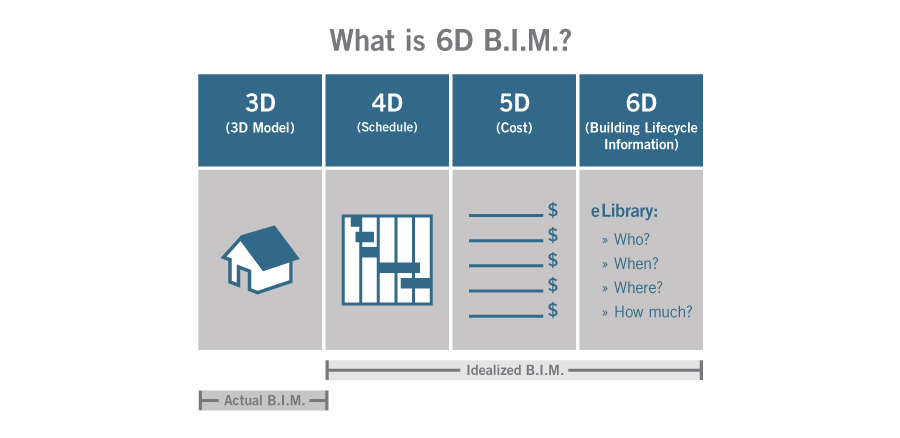Who should care?
Property Owners & Managers
Developers & Contractors
Product Manufacturers & Suppliers
Attorneys and Insurers
Welcome to the second post in our series on Building Information Modeling (B.I.M.)! If you don’t know what the heck we’re talking about, I encourage you to read the first post in this series which introduces the concept of B.I.M., talks through an industry definition, shows the opportunity for expansion, and even includes a fun video to help break it down.
For those that just need a refresher, here’s a recap of what we covered in the last post:
"B.I.M. is a sharable collection of building data, including:
A three-dimensional (3D) computer model of the entire project;
Data about each of the physical building elements including their location, number, and size;
Information related to time (4D);
Information related to cost (5D);
And all aspects of the project lifecycle (6D).”
"So what?"
Now that you know what B.I.M. is, you’re probably asking, “So what?” Why should you care about B.I.M.?
The truth is that B.I.M. introduces a transformation in the way we think about, document, and share information related to building projects – and the results have serious implications and unrealized benefits for users across every industry that deals professionally with buildings (not just the construction industry).
We’ll illustrate this with an example. As you probably know, buildings are traditionally designed graphically, even when using three-dimensional computer aided design (CAD). It’s common for an architect to design a building project using 3D CAD, then print the contract documents but not share the electronic files. Contractors offering proposals then have to manually measure the scaled drawings and input their own interpreted data in order to develop their estimates and proposals.
As you can imagine, this traditional methodology is inherently inaccurate and inconsistent. Even two estimators in the same office will have different datasets. And this messy process is repeated for each and every contractor involved, which is terribly wasteful when you consider that large projects can have hundreds of players involved.
B.I.M. presents an alternative to this inaccurate and inconsistent approach.
Accurate, Consistent Information with B.I.M.
At its core, B.I.M. is a methodology that transforms the underlying design of a building into data that can be shared with all stakeholders, without interpretation, for reuse throughout the building lifecycle.
Recall our flooring contractor from the first post: Having one dataset about the building, that can be easily shared throughout the building lifecycle, will decrease historic inefficiencies associated with parties needing to create and re-create data over and over. These savings will naturally lower the total building lifecycle costs. Those who participate by using this data will be at an advantage over those who continue to operate in the older, less efficient way. In addition, this data will make smart decisions easier, so in addition to lower costs, the performance will be better and more durable. Better and more durable building performance usually means “longer lasting,” so the cost over time is lowered ($/year).
Let’s discuss how each of our B.I.M. components becomes a living data set to be used virtually by all key players in a building project's lifecycle:
A three-dimensional (3D) computer model of the entire project:
Build a true 3D model of the building project, representing the elements (floors, walls, roof, windows, doors, etc.) that will make up the real building in three-dimensional space. This is in contrast to 3D CAD (computer aided drafting), which is a purely graphical rendition requiring interpretation (which often leaves chances for error).
Create a “home base” model from which all players in the design of the building project contribute to and pull data from.
Leverage your 3D B.I.M. as a sophisticated database to output building information in various forms, including all elements in "one dimension" like Excel spreadsheets, two dimensions like traditional construction drawings, or three dimensions from any vantage.
Eliminate costly errors in dimensions and conflicts in physical space associated with the traditional methodology.
Data about each of the physical elements including their location, number, and size:
Incorporate all physical elements of your project in your 3D model, accounting for the way that manufactured products are actually put into a real building.
Pull precise specifications and information related to physical elements that are not pre-manufactured.
Automatically account for every element, a process that traditionally requires calculations and scaling.
Incorporate service-life and maintenance information associated with each discrete building element (walls, windows, roof, mechanical equipment, etc.).
Information related to time (4D):
Associate progress schedule and sequencing information with each discrete element, combining and associating with other interrelated elements that will be combined during construction.
Efficiently and effectively communicate changes to the construction schedule with a sophisticated B.I.M. scheduling mechanism.
Incorporate maintenance intervals for each element, and output maintenance plans for those elements that require periodic attention.
Information related to cost (5D):
Include the cost of each physical element in the model.
Associate each discrete element with service-life expectations and maintenance costs, and manage throughout the building lifecycle.
Integrate lifecycle cost analysis data, including that for reserve studies.
Accurately evaluate the performance of the building against the expectation, as described in your model.
And all aspects of the project lifecycle (6D):
Do we know who designed all of the buildings we worked on? This is an easy question if you have a complete Building Information Model.
How about trying to figure out who applied the paint that is peeling off the exterior doors?
How long did we expect that paint to last anyway? And who made it? And what color is it?
This series on Building Information Modeling continues:
(This post) Building Information Modeling: Why Everyone Who Deals with Buildings Should Care about B.I.M.
Building Information Modeling: B.I.M. and Building Lifecycle Management (BLM)
To learn more about how PFCS leverages B.I.M., browse our services or give us a call at our Southern California Office (949) 240-9971 or Portland Office (503) 660-8670.


